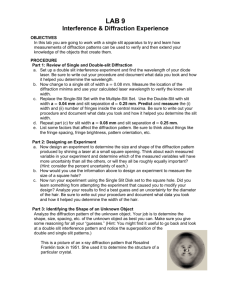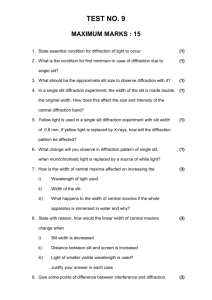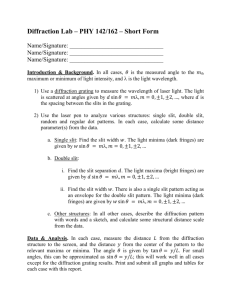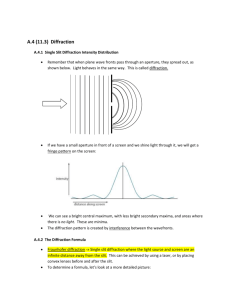DiffractionLab
advertisement
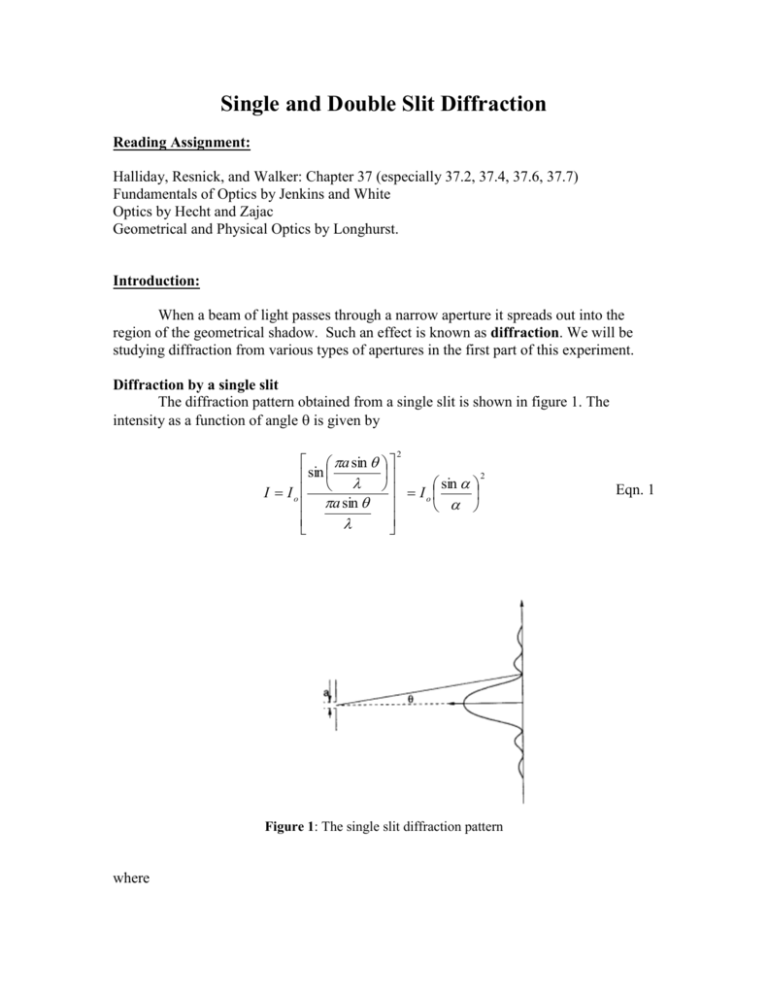
Single and Double Slit Diffraction Reading Assignment: Halliday, Resnick, and Walker: Chapter 37 (especially 37.2, 37.4, 37.6, 37.7) Fundamentals of Optics by Jenkins and White Optics by Hecht and Zajac Geometrical and Physical Optics by Longhurst. Introduction: When a beam of light passes through a narrow aperture it spreads out into the region of the geometrical shadow. Such an effect is known as diffraction. We will be studying diffraction from various types of apertures in the first part of this experiment. Diffraction by a single slit The diffraction pattern obtained from a single slit is shown in figure 1. The intensity as a function of angle is given by 2 a sin 2 sin sin I Io Io a sin Figure 1: The single slit diffraction pattern where Eqn. 1 a sin Eqn. 2 a is the slit width and is the wavelength of the light used. Io is the intensity at = 0, corresponding to the principal maximum. The diffraction pattern is formed in a direction which is perpendicular to the length of the slit. The positions of the diffraction minima in the pattern are found from the condition = ±π, ±2π, ±3π, … which yields the formula sin m a m = 1, 2, 3, ... Eqn. 3 Diffraction by a double slit Figure 2: The double slit diffraction pattern Consider a diffracting aperture consisting of two long parallel slits each of width a and separated by a distance d. The transmitted intensity is given by a sin sin I 4I o a sin 2 2 2 cos d sin 4 I sin cos 2 o Eqn. 4 where was defined in eqn. 2 and d sin Eqn. 5 The factor of 4 arises from the fact that the amplitude of the wave is twice what it would be if one slit were covered. The "diffraction'' term in eqn. 4 is recognizable as the intensity distribution for a single slit and serves as the envelope for the "interference'' term cos2 which describes the interference between the diffracted beams from each slit. The appearance of the intensity as a function of sin for the case d = 3a is shown in figure 2. If a is small, the diffraction pattern from either slit will be essentially uniform over a broad central region and interference fringes will be evident in that region. Diffraction minima are located at sin m a , m = 1, 2, 3, ... Eqn. 6 while the interference minima are located at sin m 1 2 , d m = 1, 2, 3, ... Eqn. 7 If the slit width a is kept constant and the separation d is increased (or decreased) the nature of the interference pattern changes, though the diffraction envelope itself remains unaltered. The number of interference fringes in the central diffraction maximum is (2d/a) -1. (The factor of 2 comes from identical patterns on either side of the central point. The term –1 arises because the m=+0 and m = -0 are the same) Single and Double Slit Diffraction Goals: To examine the diffraction pattern formed by laser light passing through single and double slits. To verify that the positions of the minima in the diffraction pattern match the positions predicted by theory. Materials Needed: Diode laser (OS-8525) with power supply Optics bench with centimeter scale Single Slit Disk (OS-8523) Multiple Slit Disk (OS-8523) Activity 1: Diffraction from a single slit. 1. Set up the laser on the optical bench and turn it on. is 670 nm. The wavelength of the laser Do not look into the laser or point it toward someone's eyes. 2. Fix the single slit disk in the lens holder and install it on the optics bench (about 3 cm from the laser). You should be able to see the diffraction pattern on the screen. 3. Choose the slit width a = 0.04 mm by rotating the slit disk until the desired single slit is centered. Also, set the aperture bracket to position #3. 4. Adjust the position of the laser beam from left-to-right and up-and-down until the beam is centered on the single slit. 5. Repeat the measurement with some other slit width a. Record the new width and copy the graph to the template. 6. For the 0.04 mm slit, determine the distance from the slit to the light sensor, as well as the distances between the first order (m=1) minima and the second order (m=2) minima. Enter these values in the template. Analysis. For the slit with a = 0.04 mm, calculate the slit width from the data collected in the following way: 1. Divide the distances between side orders by two to get the distances from the center of the pattern to the first and second order minima. Record those values of y in the table provided in the template. 2. Using the average wavelength of the laser (670 nm for the Diode Laser), calculate the slit width twice, once using the first order (a1) and once using the second order (a2) minima. Record the results in the table. 3. Calculate the percent differences between the experimental slit widths and 0.04 mm. Record in the table. 4. Does the distance between minima increase or decrease when the slit width is increased (or decreased, depending upon which one you used)? Activity 2: Double Slit Diffraction. 1. Place the Multiple Slit Disk in its holder about 3 cm in front of the laser. 2. Select the double slit with the 0.04 mm slit width and 0.25 mm slit separation. 3. Count the number of bright fringes within the central peak. Analysis. 1. Compare the intensities of the single and double slit diffraction patterns. Is the ratio equal to the one given by theory? 2. According to the formulae given in the introduction, how many bright fringes should there be in the central maximum? Does your answer agree with the one given in point 4 above? Explain. 3. Calculate the slit width from the data collected in the following way: Divide the distances between side orders by two to get the distances from the center of the pattern to the first and second order minima. Record those values of y in the table provided in the template. Using the average wavelength of the laser (670 nm for the Diode Laser), calculate the slit width twice, once using the first order (a1) and once using the second order (a2) minima. Record the results in the table. Calculate the percent differences between the experimental slit widths and 0.04 mm. Record in the table.

